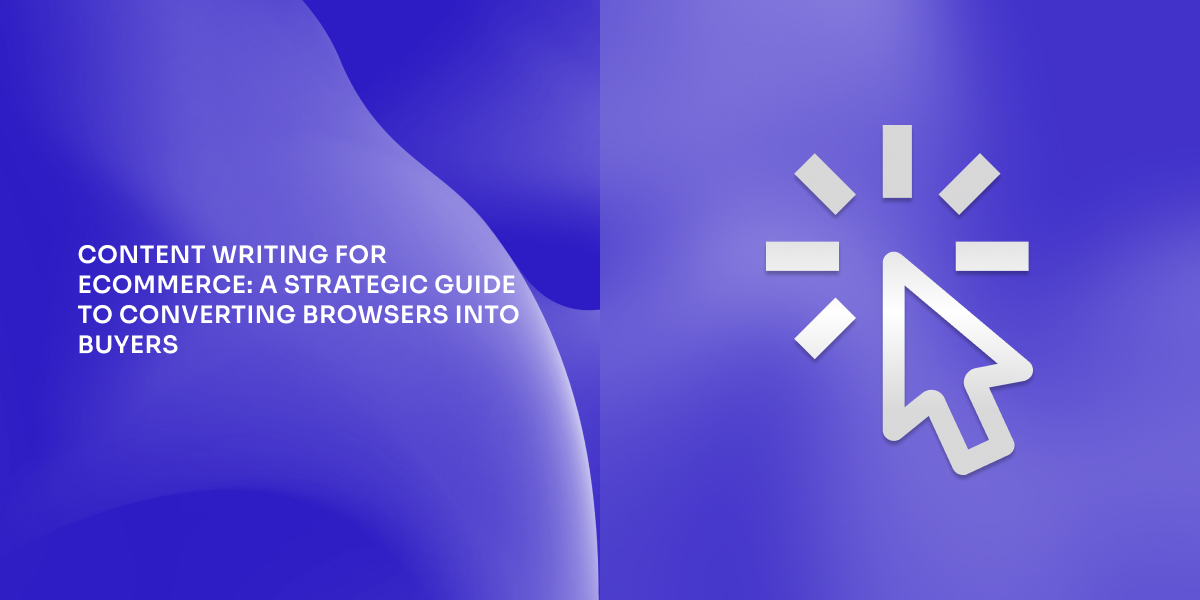Content writing for ecommerce: a strategic guide to converting browsers into buyers

A writer-marketing assistant with a background in sociology and research, Alyanna is part of the marketing team at 1902 Software. As one of the newer members, she brings a fresh perspective and a growing curiosity about how technology helps businesses—especially in the B2B sector—connect with their audiences more effectively. She contributes to the team’s efforts in creating marketing materials and supporting initiatives for both 1902 Software and WriteText.ai.

Content writing for ecommerce is unlike any other form of online writing. Blog posts inform, articles educate—but ecommerce content writing persuades. Its single mission is to turn visitors into customers. This type of writing blends persuasive storytelling, smart keyword strategy, and detailed product knowledge to create content that ranks well and sells.
The stakes are high, research shows that 69% of online shopping carts are abandoned, often due to unclear product information or unconvincing content. Meanwhile, Salsify's consumer research reveals that 87% of shoppers rate product content as extremely or very important when deciding to buy. Your words directly impact your bottom line.
Understanding ecommerce content types
Content writing for ecommerce websites covers several types of content, each serving a different purpose in your customer’s buying journey.
- Product descriptions form the foundation of your conversion strategy. These shouldn’t read like mechanical lists of specs—they should tell a story that solves customer pain points and includes relevant keywords.
For example, a product description for running shoes shouldn’t just say “made with EVA midsole.” It should explain how that midsole reduces joint impact during long runs, speaking directly to the marathon runner browsing your page. - Category pages often get neglected in content strategies, yet they represent some of your highest-traffic opportunities. Effective ecommerce website content writing for these pages balances keyword-rich introductions with easy navigation. A category page for “organic cotton t-shirts” might feature 150–200 words about sustainability, comfort, and versatility—all while weaving in natural keyword use.
- Homepage content sets your brand tone and value proposition within seconds. This is where strategic brevity matters most. Your homepage should communicate what you sell, why you're different, and what action visitors should take next—all within the first viewport.
- About pages, FAQ sections, and buying guides build trust and authority. These supporting content pieces reduce customer service inquiries while establishing your expertise, signaling to both search engines and customers that you're an authoritative source in your niche.
The strategic framework for ecommerce content
Effective content writing for ecommerce sites follow a proven framework that balances search optimization with conversion psychology.
- Start with customer research. Before writing, understand who’s buying and why. Read customer reviews—yours and your competitors’—to learn the language real people use. If multiple reviewers say a jacket “runs small,” address sizing directly in your content. You’ll solve customer concerns and naturally capture long-tail keywords.
- Map keywords to intent stages. Not all searches mean the same thing. A query like “buy waterproof hiking boots size 10” signals a ready-to-purchase customer, while “what boots are best for hiking” shows early research intent. Match your content to intent—transactional keywords for product pages, informational ones for blogs and guides.
- Lead with benefits, follow with features. A common pitfall in ecommerce content writing is leading with specifications. Customers don't care that a blender has a 1200-watt motor until they understand that power crushes ice in three seconds for perfect smoothies. Benefits answer "what's in it for me?"—features provide the proof.
- Use social proof. Integrate testimonials, reviews, or data that validate your claims. “Trusted by over 10,000 customers” builds credibility far faster than “we make great skincare.” This approach also aligns with Google’s E-E-A-T principles—showing expertise, experience, authority, and trustworthiness.
Writing product descriptions that convert
Product descriptions represent the highest-leverage content on your site. Here's how to write them effectively:
- Use the inverted pyramid structure. Place your most compelling information first. The opening sentence should communicate the primary benefit or unique selling proposition. Follow with supporting details, specifications, and finally, care instructions or additional features. Many customers won't read past the first paragraph—make it count. Optimize for scanners and readers.
- Optimize for both scanners and readers. Optimize for both scanners and readers—79% of web users scan pages rather than read word-for-word, so break dense paragraphs into bullet points for key features and use bold text to highlight details like “waterproof up to 100 meters” or “machine washable.”
- Address objections preemptively. Include fit guides, durability notes, or warranty details to reassure hesitant buyers.
- Keep your brand voice. Add personality—but never at the cost of clarity. A light tone fits lifestyle brands; precision works better for technical ones. Match your audience’s expectations.
Common pitfalls in ecommerce content creation
Even experienced writers stumble when adapting to content writing for ecommerce websites. Watch out for these common mistakes:
- Copying manufacturer descriptions. Duplicate content hurts both SEO and credibility. Create unique text tailored to your audience—even if you start from manufacturer data, rewrite it with context.
- Keyword stuffing. Phrases like “buy blue running shoes for women cheap” kill readability and hurt rankings. Search engines now understand meaning and context—write naturally.
- Ignoring mobile users. With mobile commerce representing over 70% of ecommerce traffic according to Statista, your content must work on small screens. Keep paragraphs short (2-3 sentences), use ample white space, and front-load important information.
- Skipping content updates. Search engines favor fresh, regularly updated content. Review and refresh product descriptions quarterly, especially for seasonal items or products with new features.
When to use AI vs. manual control
AI tools like WriteText.ai have transformed ecommerce content writing workflows. The secret is knowing when to automate and when to stay hands-on.
Use AI for:
- Generating first drafts of product descriptions at scale, particularly for large catalogs with similar items
- Creating meta descriptions and title tags that incorporate target keywords
- Producing variation testing for A/B experiments across multiple product descriptions
- Expanding bullet points into full paragraphs while maintaining consistent brand voice
- Translating content for international markets while preserving tone
Maintain manual control for:
- High-value product pages where small conversion improvements yield significant revenue
- Brand storytelling on homepages, about pages, and mission-driven content
- Complex products requiring technical expertise or industry-specific knowledge
- Topics requiring sensitive handling or fact verification.
- Final editing and QA for tone and accuracy.
The most effective approach combines both. Use AI to generate baseline content that incorporates keywords and follows structural templates, then apply human expertise to refine messaging, inject brand personality, and ensure accuracy. This hybrid model can increase content production by 5-10x while maintaining quality standards.
Measuring content performance
Great content writing for ecommerce should show results. Track these metrics to measure performance and guide improvements:
- Conversion rate. Compare product page conversions against your site average. Pages that underperform often need content rewrites.
- Time on page and scroll depth indicate engagement. If visitors leave within 10 seconds, your content isn’t capturing attention. Use tools to see where readers drop off.
- Organic search traffic. Monitor monthly keyword rankings and organic traffic. If rankings rise but clicks don’t, rework meta descriptions to improve click-through rates.
- Cart abandonment rate. Products with unclear content or missing info often have higher abandonment. Cross-check with customer service inquiries to identify content gaps.
- Customer feedback. Repeated questions or return reasons like “not as described” point to weak or misleading descriptions. Update these pages first.
Implementing a sustainable content strategy
Creating excellent ecommerce content once isn't enough—you need a system to keep it consistent and up to date.
- Build templates. Standardize layouts for categories and products. For example, “athletic shoes” templates can include sections for use case, key technologies, and care instructions.
- Create a style guide. Define your voice, formatting, and keyword practices to maintain brand consistency across writers and AI.
- Audit regularly. Review pages quarterly to refresh outdated info and identify opportunities. Focus first on high-traffic, high-revenue items. Some tools automate this process to keep product content fresh and optimized.
- Test continuously. A/B test description formats, headline styles, and call-to-action placement. Small improvements compound across thousands of products.
Key takeaway
Successful ecommerce content writing balances two priorities: visibility and conversion. Write for humans first, optimize for search second. Ground your copy in real customer needs, back your claims with specifics, and measure what matters.
Whether you’re crafting descriptions by hand or using tools like WriteText.ai to scale production, the goal is the same—turn product information into persuasive, conversion-driven stories that make shoppers click add to cart.